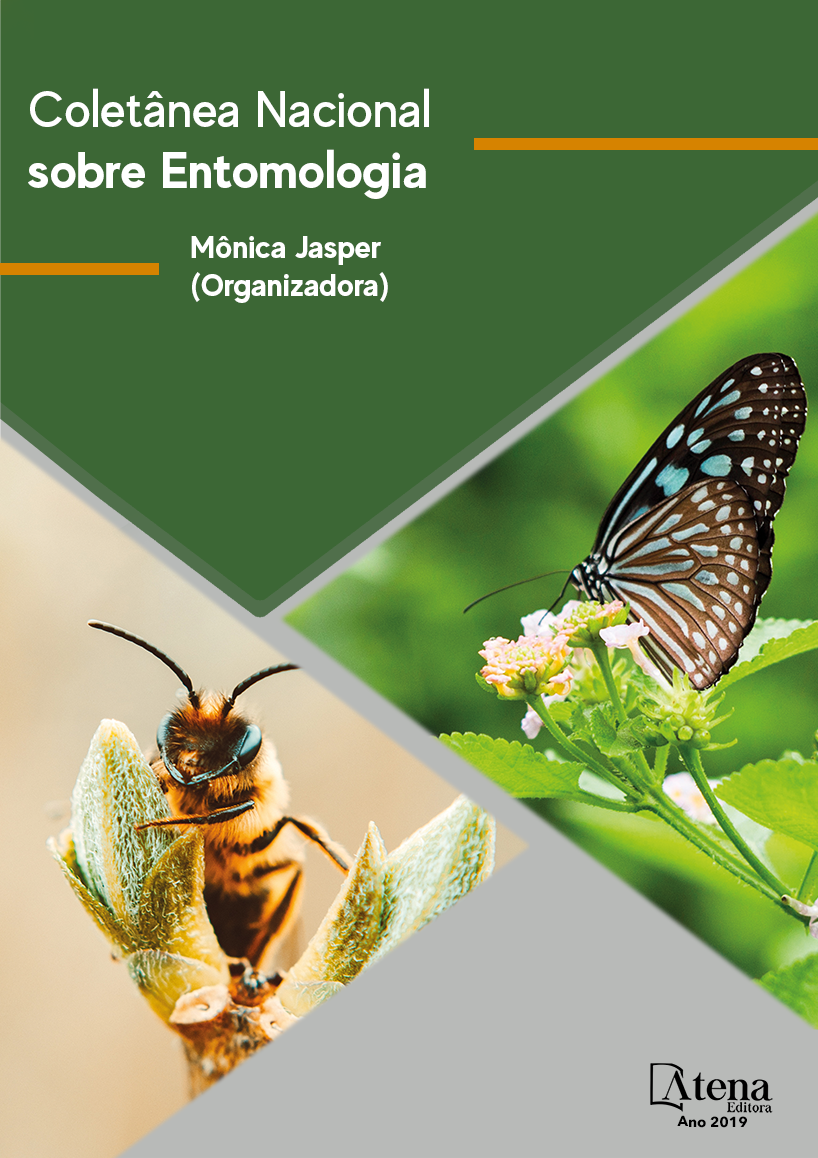
ATIVIDADE INSETICIDA DE ESPÉCIES DE Ludwigia L. (MYRTALES: ONAGRACEAE) SOBRE OVIPOSIÇÃO DA TRAÇA-DAS-CRUCÍFERAS
A investigação do potencial
inseticida das espécies vegetais é necessária,
pois há uma necessidade de medidas
alternativas de controle de pragas como o
microlepdóptero Plutella xylostella (L.1758)
(Lepidoptera: Plutellidae). Sendo assim,
o objetivo do trabalho foi verificar o efeito
deterrente de espécies de Ludwigia (Myrtales:
Onagraceae) sobre a oviposição de P. xylostella.
Os extratos aquosos de Ludwigia tomentosa
(Cambess.) H. Hara, Ludwigia longifolia (DC.)
H. Hara, Ludwigia sericea (Cambess.) H.
Hara e Ludwigia nervosa (Poir.) H. Hara foram
preparados a partir das folhas, pela de técnica
de maceração na concentração de 10%. Os
discos de couve foram imersos nos extratos
e transferidos para as gaiolas de oviposicão.
Para o tratamento controle foi utilizada água
destilada. Em cada gaiola foi inserido um casal
de P. xylostella com até 12 horas de idade,
proveniente de criação feita em laboratório.
Os casais foram mantidos durante quatro dias
nas gaiolas de oviposição. Os parâmetros
analisados foram números de ovos e percentual
de lagartas eclodidas. O delineamento
experimental foi inteiramente casualizado constituído de cinco tratamentos, quatro
de extratos e um controle. Cada tratamento foi constituído de 10 repetições. Cada
repetição foi representada por uma gaiola contendo um casal de P. xylostella. Os
dados foram submetidos à análise de variância e as médias comparadas pelo teste
de Scott-Knott a 5% de probabilidade. Houve redução no número de ovos/dia (F =
2,1158; p = 0,0936) do controle (29,87± 6,19) em relação aos extratos de L. longifolia
(14,85± 5,84), L. sericea (14,72± 3,60) e L. nervosa (14,57± 4,51). Apesar dos menores
percentuais de lagartas eclodidas nos extratos de L. tomentosa (27,69%), L. longifolia
(14,83%), L. sericea (21,57%) e L. nervosa (15,08%), não houve diferença significativa
(F = 2,9054; p = 0,0543) do controle (42,89%). Espécies de Ludwigia apresentam
potencial inseticida, contudo o teste deverá ser refeito com novas concentrações e
solventes, e os compostos químicos devem ser isolados para novos testes.
ATIVIDADE INSETICIDA DE ESPÉCIES DE Ludwigia L. (MYRTALES: ONAGRACEAE) SOBRE OVIPOSIÇÃO DA TRAÇA-DAS-CRUCÍFERAS
-
DOI: 10.22533/at.ed.50419090710
-
Palavras-chave: Brássicas; Extrato botânico; Plutella xylostella
-
Keywords: Brassicas; Botanical extract; Plutella xylostella
-
Abstract:
The investigation about the insecticidal potential of plant species is
necessary because of the necessity of alternative measures of pest control such as
the microlepdoptero Plutella xylostella (L., 1758) (Lepidoptera: Plutellidae). Thus, the
goal of this work was to check the derretent efect of espécies of Ludwigia (Myrtales:
Onagraceae) on the oviposition of P. xylostella. The extracts of Ludwigia tomentosa
(Cambess.) H. Hara, Ludwigia longifolia (DC.) H. Hara, Ludwigia sericea (Cambess.)
H. Hara and Ludwigia nervosa (Poir.) H. Hara were prepared from the leaves by
the technique of maceration at the concentration of 10%. The cabagge discs were
immersed in the extracts and transfered to the oviposition cages. For the treatment of
control was utilized distilled watter. In each cage was inserted a couple of P. xylostella
with up to 12 hours of age, coming from a laboratory establishment. The couples were
kept during four days in the oviposition cages. The analyzed parameters were the
eggs number and percentual of caterpillars hatched. The experimental design was
completely randomized, consisting of five treatments, four of extracts and one control.
Each treatment consisted of 10 replicates. Each replicate was represented by a cage
containing a pair of P. xylostella. The data were submitted to analysis of variance
and the means were compared by the Scott-Knott test at 5% probability. There was a
reduction in the number of eggs / day (F = 2.1158; p = 0.0936) of the control (29.87±
6.19) in relation to L. longifolia (14.85± 5.84), L. sericea (14.72± 3.60) and L. nervosa
(14.57± 4.51). In spite of the smaller percentage of caterpillars hatched in the extracts
of, L. tomentosa (27.69%), L. longifolia (14.83%), L. sericea (21.57%) and L. nervosa
(15.08%), there was no significant difference (F = 2.9054, p = 0.0543) of the control
(42.89%). The Ludwigia species exhibit insecticidal potential, however, the test should
be redone with new concentrations and solvents, the chemical compounds should be
isolated for further testing.
-
Número de páginas: 15
- Camila Benitez Vilhasanti
- Silvana Aparecida Souza
- Matheus Moreno Mareco Silva
- Isabella Maria Pompeu Monteiro Padial
- Alberto Domingues
- Eduardo Carvalho Faca
- Andressa da Silva Matiasso
- Rosilda Mara Mussury
- Eliana Aparecida Ferreira


